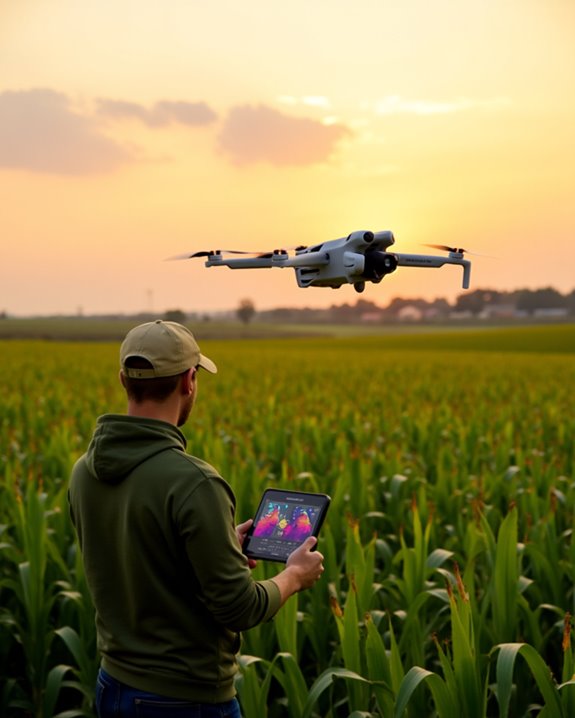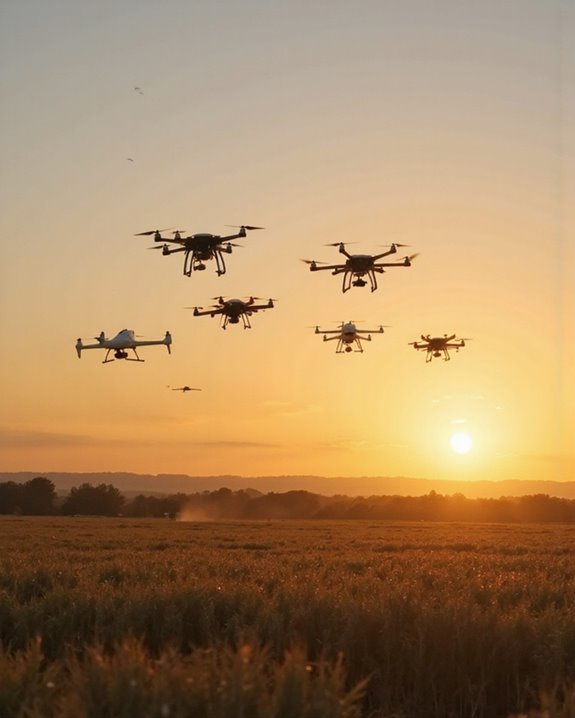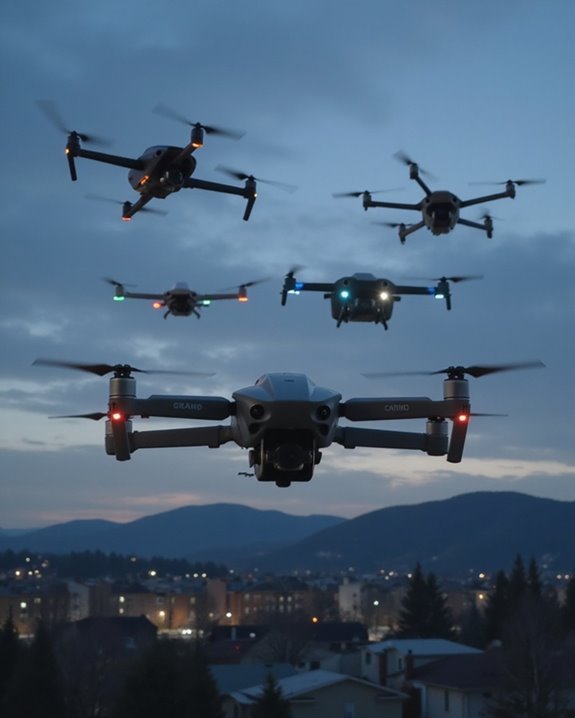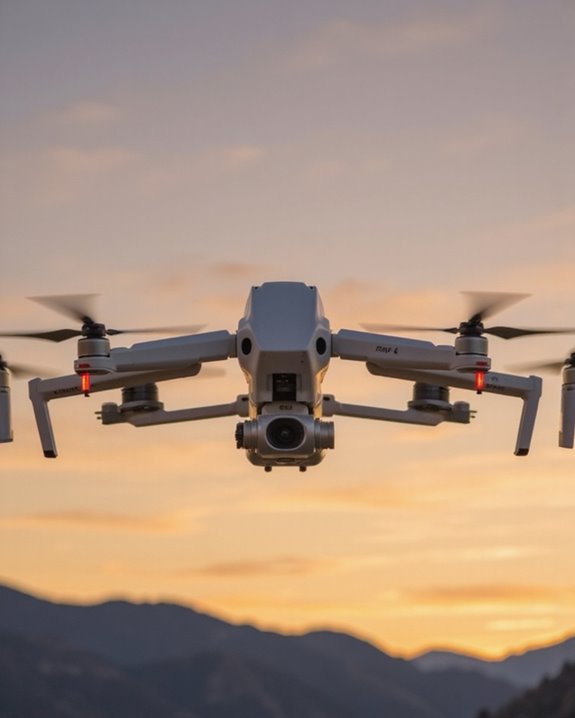The three best agriculture drones for today’s tech-savvy farmers are the DJI Agras T50 with its premium 10-15kg payload capacity, the 4K Brushless Motor Drone featuring exceptional L6 wind resistance, and the Bwine F7 GPS Drone with its impressive 3-axis gimbal for stable imaging. You’ll love how these powerhouses combine RTK positioning accuracy, extended flight times (up to 75 minutes with multiple batteries), and precise spraying capabilities! These aerial workhorses transform traditional farming into efficient, data-driven operations without breaking a sweat.
Key Takeaways
- Agricultural drones with brushless motors provide superior stability and efficiency in winds up to L6 levels.
- Top models offer 75-minute flight times using triple battery configurations for extensive field coverage.
- RTK technology delivers centimeter-level positioning accuracy for precise field mapping and autonomous navigation.
- 4K cameras with stabilized gimbals capture detailed crop imagery for identifying pest infestations and nutrient deficiencies.
- Leading agricultural drones feature 10-15kg payload capacities and 20+ liter tanks for efficient spraying operations.
Agriculture Drone Centrifugal Motor for DJI Agras T50
Professional farmers and agricultural enterprises looking to maximize efficiency will find the Agriculture Drone Centrifugal Motor for DJI Agras T50 an essential component for their advanced farming operations. This high-quality motor delivers exceptional durability that you’ll appreciate during those long spraying sessions over your fields.
Before installation, you’ll want to verify compatibility with your specific drone model. While the motor is designed for the DJI Agras T50, it’s always wise to double-check! The installation process requires careful attention—some components are complex and might need a professional’s touch. Don’t worry though, once properly installed, the premium materials used in this motor will give you peace of mind as your drone buzzes efficiently over your crops!
Best For: Professional farmers and agricultural enterprises operating DJI Agras T50 drones who need reliable, high-quality replacement parts for their precision farming operations.
Pros:
- High-quality construction with premium materials ensures exceptional durability during extended agricultural drone operations
- Specifically designed for compatibility with the DJI Agras T50 agricultural drone system
- Enhances operational efficiency for long spraying sessions across large farming fields
Cons:
- Complex installation process may require professional assistance to avoid mistakes
- Compatibility limited to specific drone models, requiring verification before purchase
- No additional details provided about warranty coverage or expected lifespan
Drones with Camera for Adults 4K Brushless Motor Drone with Propeller Guards
- 【Ultimate Fusion: 4K HD Camera, Image Stabilization, and FPV】Equipped with image stabilization technology, our 4K UHD camera delivers sharper visuals through faster...
- 【Brushless Drones: Stability, Efficiency, Wind Resistance】Compared to brushed models, brushless drones boast longer lifespan and lower power consumption, ensuring...
- 【Dual-Battery Upgrade: Longer Flight, More Portable】The upgraded dual-battery setup equips two enhanced batteries, extending flight time to 32 minutes. Utilizing USB...
Farmers seeking advanced aerial monitoring will find the 4K Brushless Motor Drone with Propeller Guards a game-changing addition to their agricultural toolkit. You’ll capture crystal-clear footage of your fields with the impressive 3840×2160 resolution camera, complete with image stabilization and a wide 130° lens that doesn’t miss a thing!
The brushless motor isn’t just a fancy feature—it delivers real performance with better wind resistance and stability when you’re checking those far corners of your property. With dual 1500mAh batteries providing up to 32 minutes of flight time, you won’t be left high and dry mid-inspection. The best part? No FAA registration required for your flying field assistant!
Best For: Farmers and agricultural professionals looking for an affordable, user-friendly drone with good image quality to monitor crops and inspect fields without requiring FAA registration.
Pros:
- 4K UHD camera with image stabilization and 130° wide-angle lens provides excellent aerial imagery for crop monitoring and field assessment
- Dual 1500mAh batteries offer extended flight time (up to 32 minutes total) with quick USB 3.0 charging capability
- Brushless motors deliver better stability, efficiency and wind resistance than brushed motor alternatives, making it reliable for outdoor agricultural use
Cons:
- Limited 100-meter maximum range restricts monitoring of larger agricultural properties
- 15-16 minute actual flight time per battery is significantly less than the advertised 32 minutes
- No advanced autonomous flight paths or waypoint capabilities that would benefit systematic field scanning and crop assessment
Bwine F7 GPS Drone with 4K Camera and 3-Axis Gimbal
No products found.
The agricultural mastermind seeking extended flight coverage will find their match in the Bwine F7 GPS Drone. With an impressive 75-minute flight time using three batteries, you’ll cover more acres without constant landings to swap power.
You’re getting FAA-certified equipment that won’t cause regulatory headaches, complete with a remote ID for compliance. The 3-axis gimbal paired with 4K resolution delivers crystal-clear field imagery that’ll make crop assessment a breeze! Need night monitoring? The enhanced CMOS sensor has you covered. When your drone ventures far, don’t worry – the 3000m control range and auto-return features guarantee your investment won’t become an expensive field decoration.
Best For: Agricultural professionals and farmers seeking extended field monitoring capabilities with high-quality imaging and reliable performance for comprehensive crop assessment and management.
Pros:
- Exceptional 75-minute flight time with three batteries enables extensive coverage of large agricultural areas without frequent interruptions
- FAA-certified with remote ID compliance eliminates regulatory concerns while operating in agricultural settings
- Advanced 4K camera with 3-axis gimbal and night vision capabilities provides clear imagery for detailed crop assessment in various lighting conditions
Cons:
- Battery charging time of 6-7 hours may require significant downtime between comprehensive field monitoring sessions
- No mention of waterproofing or dust resistance ratings that would be beneficial for agricultural environments
- Lacks specialized agricultural software features like NDVI mapping that would enhance its utility specifically for farming applications
Factors to Consider When Choosing an Agriculture Drone

Selecting the right agriculture drone isn’t just about finding the newest model—it’s about matching specific features to your farm’s unique needs! You’ll want to weigh essential factors like motor type, battery capacity, GPS capabilities, camera resolution, and spraying capacity before making your investment. These key considerations will determine whether your drone becomes an invaluable farming assistant or an expensive toy gathering dust in your equipment shed.
Motor Type Considerations
Power beneath the propellers, specifically the motor type you choose, can make or break your agriculture drone’s performance in the field! Brushless motors are your best bet, offering enhanced stability and efficiency that’ll keep your drone running smoothly while consuming less energy during those long survey flights.
You’ll want motors that can handle Mother Nature’s mood swings, as the right design lets your drone maintain steady control in winds up to L6 levels. Higher efficiency motors enable faster speeds, letting you cover those sprawling fields in record time. Don’t skimp on durability either – quality materials prevent frequent replacements when you’re knee-deep in the growing season. For those farming in varied terrain, select motors that maintain precise altitude control up to 2000 meters, ensuring your spraying and monitoring remain spot-on regardless of elevation!
Battery Life Capacity
Moving from motors to what keeps them humming, battery life capacity stands as your field operation’s true heartbeat! When selecting your agriculture drone, pay close attention to the mAh rating – higher numbers translate directly to more acres covered without interruption.
You’ll find most agricultural drones offer between 15-75 minutes of flight time per battery, depending on your payload and motor efficiency. Don’t worry too much about a single battery limitation, though! Smart farmers keep multiple batteries on hand for quick swaps, minimizing downtime during those vital spraying windows.
Consider the long game, too – quality batteries typically last around 500 recharge cycles before needing replacement. And don’t overlook charging infrastructure! The difference between waiting 6 hours versus 7 can mean squeezing in that extra field survey before sundown!
Navigation and GPS
The backbone of any agriculture drone’s effectiveness lies in its navigation and GPS capabilities! You’ll want to look for drones equipped with RTK systems that deliver centimeter-level accuracy, perfect for those precise spraying or planting operations. Trust me, there’s nothing more frustrating than a drone that can’t tell the difference between your crops and your neighbor’s fence!
Most top-tier agriculture drones now feature multi-constellation support—combining GPS, GLONASS, and Galileo signals—giving you reliable positioning even when flying over dense crop canopies. When shopping around, prioritize models with autonomous waypoint navigation, which lets your drone efficiently cover vast acreage while you sip coffee in the shade. Don’t overlook safety features like auto-return functionality, which can be a real lifesaver when battery levels drop unexpectedly or signals weaken in remote areas.
Camera Quality Requirements
When selecting an agricultural drone, camera specifications serve as your eyes in the sky! You’ll want to prioritize 4K resolution (3840×2160 pixels) to capture those tiny pest infestations and nutrient deficiencies that wouldn’t be visible with standard cameras.
Don’t underestimate the power of good image stabilization—those breezy field conditions won’t stand a chance with a quality gimbal system! A wide field of view (120°+) means you’re covering more corn rows per flight, saving you precious battery life and time.
Look for drones with advanced CMOS sensors that perform well during those golden-hour inspections at dawn or dusk. And remember, a decent digital zoom (up to 5x) lets you get a closer look at suspicious crop spots without buzzing down to scare the local wildlife—or worse, your neighbor’s curious cattle!
Payload and Spraying Capacity
Powerful payload capacity stands as the backbone of any serious agriculture drone, transforming your flying machine from a simple camera carrier into a workhorse that tackles real field problems! When selecting your drone, look for models that can handle at least 10-15kg to make sure you’re not constantly landing for refills.
Your spraying capacity, measured in liters per minute, directly impacts your field efficiency. A high-performance drone with 2-3 L/min output will dramatically cut your work time compared to budget options. Don’t overlook tank volume, either—a 20+ liter reservoir means fewer pit stops during operation.
For maximum effectiveness, consider the spraying width. A drone covering 5-7 meters per pass will finish the job in half the time of narrower models. Remember, stability under load isn’t just a spec—it’s what keeps your expensive chemicals on your crops, not drifting to your neighbor’s yard!
Weather Resistance Features
Harsh weather conditions can quickly transform your productive drone operation into an expensive disaster without proper protection! You’ll want to look for drones with wind resistance ratings of at least 10-15 meters per second, which keep your aircraft stable even when those unexpected gusts kick up during spraying operations.
Don’t settle for anything less than IP54 protection (at minimum), which shields your investment from both dust and water ingress. The best ag drones feature materials that perform reliably in temperatures ranging from -10°C to 40°C, ensuring you’re covered from frosty mornings to scorching afternoons. Advanced stabilization systems are also worth the investment, as they’ll help your drone maintain precise flight paths despite turbulence. And remember, those moisture-resistant coatings on batteries and electronics aren’t just fancy add-ons—they’re essential for those dewy dawn flights!
Flight Time Efficiency
How long your drone can stay airborne directly impacts your farm’s productivity and your bottom line! Today’s top agricultural drones offer impressive flight times ranging from 15-16 minutes per battery, but you’ll want to evaluate models that accommodate multiple battery setups for maximum efficiency. With dual or triple battery configurations, you’re looking at 32-75 minutes of continuous operation — enough to cover substantial acreage without frustrating pit stops!
When evaluating battery performance, don’t just look at the mAh rating; check the recharge cycle count too. Models supporting 500+ cycles will serve you longer, saving you money on replacements. And don’t forget about wind resistance! Drones rated for L6 wind levels won’t waste precious battery power fighting breezes, giving you more actual working time. After all, what good is a drone that spends more time charging than flying?
Installation Complexity Factors
Unpacking your new agricultural drone shouldn’t feel like disarming a bomb! When evaluating options, pay close attention to assembly requirements, as they can range from simple 5-part systems to complex 15-component configurations that demand precision within 1-2 millimeters for proper flight stability.
Consider the time investment required—you’ll spend anywhere from 30 minutes to over 2 hours on setup, depending on your experience and the drone’s complexity. Don’t forget to check if specialized tools are needed for those delicate electronic connections! Your best bet? Look for models with detailed instructional resources, preferably with step-by-step diagrams that can reduce installation errors by up to 40%. After all, the last thing you want is your expensive new helper taking a nosedive because of a loose wire!
Frequently Asked Questions
What Licenses or Certifications Are Required to Operate Agricultural Drones?
You’ll need a Remote Pilot Certificate with a small UAS rating from the FAA (Part 107 certification), which requires passing a knowledge test. For agricultural applications specifically, you might also need pesticide applicator licenses if you’re spraying chemicals! Some states have additional requirements, so check your local regulations before launching your drone. Don’t forget, you’ll also need to register your drone with the FAA if it weighs over 0.55 pounds. Happy farming from above!
How Long Does It Take to Learn Drone Operation for Farm Use?
You’ll be flying your farm drone with confidence in just 2-4 weeks of dedicated practice! Basic flight skills take about 5-10 hours to master, but understanding agriculture-specific applications (crop monitoring, spraying techniques) requires additional time. Many farmers become comfortable with routine operations after 15-20 flight hours, though specialized applications like precision mapping might take longer. Don’t worry – the learning curve isn’t steep, and many training programs can fast-track your journey to becoming a drone-savvy farmer!
Can Agricultural Drones Operate Effectively in High Winds or Rain?
Most agricultural drones struggle in challenging weather conditions. You’ll find that wind tolerance varies by model, with professional-grade drones handling up to 15-20 mph winds, while consumer models might only manage 10-12 mph. Rain is more problematic—few drones are truly waterproof! For better results, you’ll want to schedule your drone operations during calmer, drier periods. Some manufacturers, like DJI’s Agras series, offer weather-resistant options that can withstand light precipitation, but they’ll cost you substantially more!
How Do Drones Integrate With Existing Farm Management Software?
You’ll love how modern drones seamlessly integrate with your farm management software! Most agricultural drones connect to platforms like John Deere Operations Center, Trimble Ag, or FarmLogs through APIs, letting you import field maps, export collected data, and analyze everything in one place. Your drone’s imagery, crop health assessments, and yield predictions can flow directly into your existing dashboard, creating actionable insights without switching between systems. It’s like having your digital farmhand working directly with your virtual office!
What Maintenance Schedule Should Be Followed for Agricultural Drones?
Your drone could fail mid-flight over your precious crops! To prevent disaster, you’ll need a consistent maintenance routine. Check batteries and propellers before every flight, clean sensors weekly, and update firmware monthly. Every 50 flight hours, inspect motors and electronic components thoroughly. After each growing season, perform thorough maintenance including frame inspection and calibration of all sensors. Don’t forget to maintain detailed maintenance logs—they’re invaluable for troubleshooting and warranty claims!







